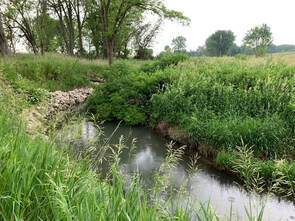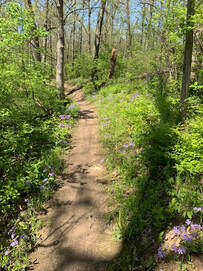
By Kathryn Foster, Citizen Scientist, Friends of EverBloom Board
Minerals in adjacent soil, chemicals washing downstream from fields, and upstream industry all impact stream water quality. As a result, every water body is unique and each water treatment plant must filter out a unique set of contaminants.
A program named RiverWatch sends out trained Citizen Scientists every year, in May and June, to test stream water quality. Teams test by searching for macroinverterbrates, or insect larvae. Healthy streams contain a wide variety of insect larvae in the spring, before larvae hatch and the insects emerge. Streams with large amounts of contamination have fewer insect larvae. Citizen scientists also measure stream depth, water clarity, temperature and flow. They note any algae or aquatic vegetation as well as the types of plants growing adjacent to the streams. Monitors also look for mussels, and any invasive species.
In our community, Riverwatch teams test the feeder streams that empty into local reservoirs. Lake Bloomington gets most of its water from Money Creek with a smaller amount coming in at the south edge from Hickory Creek. Evergreen Lake gets much of its water from Six Mile Creek on the south side of the reservoir. Four tributaries feed into Six Mile Creek (and eventually the Lake). Two other streams: T2 and T3 supply the remainder directly into Evergreen Lake.
Riverwatch Citizen Scientists have tested three of the streams over the years. T3 has been tested three times. Teams tested Hickory Creek twice and Money Creek once. The team tested T-2 this year to get a baseline for water quality since the installation of rip rap last fall.
The testing goal is to identify trends that can inform the local water providers about treatment needs, and consumers about the state of the Bloomington water supply quality. Ideally, we would like to test all the feeder streams to get a better idea of what is coming in to the reservoirs and where it’s coming from, but high water levels have been a challenge.
Lab sessions happen later in the summer to identify the larvae and other things found in each stream. This data goes into a statewide database to show problem areas and identify trends. Stream water quality ratings for the local streams in the past have ranged from excellent to poor. In past years, T-3 and Money Creek received good ratings while Hickory Creek earned a poor rating.
In agricultural areas, contamination can come from field chemicals used to fertilize or control pests. It can also come from chemicals used to de-ice roads in the winter, or high phosphorus levels caused by animal and bird feces. Spring and fall rains wash these chemicals into area streams. The chemicals reduce oxygen levels in the water needed for larvae to grow. Later in the summers the impact of chemicals shows up as algae blooms. Keeping these chemicals from polluting streams is an ongoing challenge.
The City of Bloomington in conjunction with the McLean County Soil and Water Conservation District work to maintain and improve the health of both reservoirs as the City depends on them for water supply. Pollution is only one concern.
Silt is the biggest problem in Lake Bloomington and Evergreen Lake. Silt washes off the streambanks during heavy rains. Wind and wave action on the lakes wash away shorelines, undercutting trees and other vegetation that also fall into the lakes. All that silt (that can contain runoff from fields) sinks to the bottom of the lakes, reducing water capacity. In the past five years, the City and partners have added Rip Rap (large rocks) along the northern shoreline of Evergreen Lake to help hold the soil in place. Rip Rap also been placed along the T-2 and T-3 feeder streams on the south end of Evergreen Lake to prevent heavy rains from washing away the streambanks. It’s working, but it can’t undo the damage done by years of siltification.
Getting into the creeks is fun and educational. Residents can take the Citizen Scientist course and sign up to monitor their favorite stream each year. Learn more about RiverWatch programs and how to become a Citizen Scientist at their website. Contact Friends of EverBloom if you’d like to learn more.
Local Water Facts:
- Normal residents receive their water from wells.
- Bloomington residents get their water from Lake Bloomington and Evergreen Lake.
- Well users must test water regularly and adjust their own treatment plan for safe tap water.
- Both municipalities test and treat their water to meet all federal EPA standards.
- Some residents take an extra step and test and filter their tap water to remove any residual contaminants.


 RSS Feed
RSS Feed
